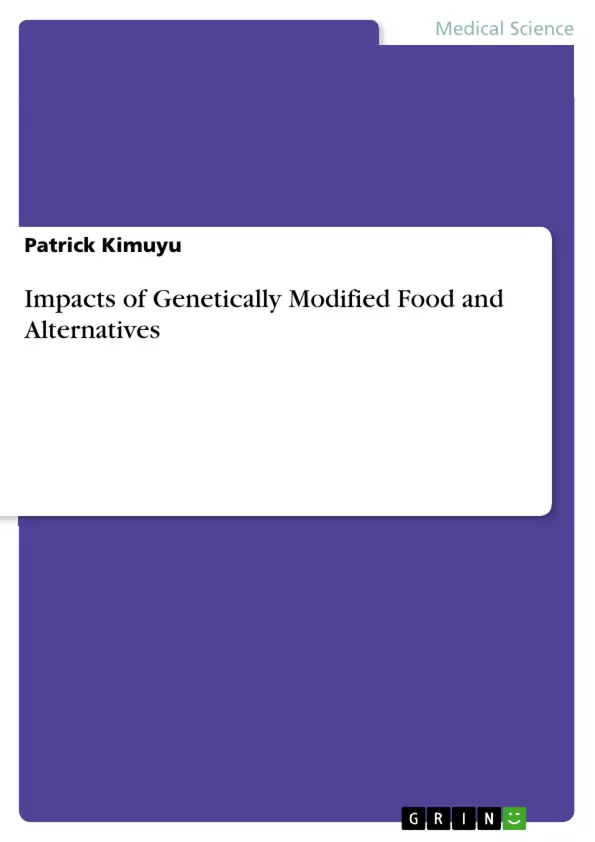In recent years, biotechnology has been the mainstay technology in both agricultural and medical field. This technology has led to the development of new medical techniques such as gene therapy for genetic disorders and diagnostic tools. In the field of agriculture, biotechnology, primarily genetic engineering has led to a substantial breakthrough in food production. It has led to the creation of transgenic plants and animals which express the desired characteristics such as high yield productivity, drought and disease resistance, as well as nutritional profile. In practice, genetic engineered organisms; plants and animals, are created through modifying their wild genomic composition to express new traits (FDA, 2014). These organisms are described as genetically transformed and their genetic composition is relatively different from that of the original or natural organisms referred to as ‘wild type.’ These genetically engineered plants have been found to enhance food production; thus considered as the modern-day solution to global food crisis. Despite the benefits associated with genetically engineered crops, seeds by Monsanto have been shadowed by immense controversy over safety issues. An endless debate over the safety of genetically engineered seeds has raised an unprecedented outcry over health and environmental concerns. Therefore, this research paper will provide an elaborate discussion on the impacts of genetically modified food.
Inhaltsverzeichnis (Table of Contents)
- Introduction
- The History of Genetically Modified Seeds
- The First Genetically Modified Crop
- The Rise of Monsanto
- The Role of Monsanto in Tackling Global Food Crisis
- The Problems of Genetically Modified Food
- Health Problems Related to Genetically Modified Food
- Developmental and Reproductive Toxicity
- Allergic Reactions
- Antibiotic Resistance
- Impact on Normal Microflora
- Environmental Problems
- Impact on Ground and Water
- Alternatives to Genetically Modified Seeds
- Conclusion
Zielsetzung und Themenschwerpunkte (Objectives and Key Themes)
This research paper explores the impacts of genetically modified food, focusing on the history of its development, the role of Monsanto in addressing global food shortages, and the potential health and environmental problems associated with its use.
- The history of genetically modified seeds, from the discovery of recombinant DNA to the introduction of the first genetically modified tomato.
- The role of Monsanto in tackling the global food crisis through the development of genetically modified crops that increase yield and reduce costs.
- The potential health risks of genetically modified food, including allergic reactions, antibiotic resistance, and developmental and reproductive toxicity.
- The environmental impacts of genetically modified food, including the impact on ground and water quality.
- Alternative approaches to addressing global food security that do not rely on genetically modified seeds.
Zusammenfassung der Kapitel (Chapter Summaries)
- Introduction: This chapter introduces the concept of genetically modified food, its potential benefits and concerns, and outlines the paper's scope and focus. The chapter highlights the role of biotechnology in both the medical and agricultural fields, emphasizing the potential of genetically engineered organisms to enhance food production and address global food security.
- The History of Genetically Modified Seeds: This chapter traces the development of genetically modified seeds, starting with the discovery of recombinant DNA in 1973 and culminating in the commercialization of the Flavr Savr tomato in 1994. It highlights the key milestones in the development of genetic engineering technology and its application in agriculture, including the development of pest-resistant crops and the introduction of the "terminator technology."
- The Role of Monsanto in Tackling Global Food Crisis: This chapter examines the role of Monsanto in the global food crisis, arguing that their genetically modified seeds offer a potential solution through increased yields and reduced production costs. It explores the company's innovations in food production and weed control, showcasing its commitment to tackling global food insecurity.
- The Problems of Genetically Modified Food: This chapter delves into the potential problems associated with genetically modified food, focusing on both health and environmental concerns. It examines the risks of allergic reactions, antibiotic resistance, and developmental and reproductive toxicity associated with genetically modified crops. The chapter also explores the potential impact on the environment, including ground and water contamination.
Schlüsselwörter (Keywords)
Genetically modified food, biotechnology, genetic engineering, Monsanto, global food crisis, health risks, environmental impacts, alternative approaches, food security, agricultural production, recombinant DNA, transgenic organisms, pest resistance, herbicide tolerance, allergic reactions, antibiotic resistance, developmental toxicity, reproductive toxicity, ground and water contamination.
- Arbeit zitieren
- Patrick Kimuyu (Autor:in), 2018, Impacts of Genetically Modified Food and Alternatives, München, GRIN Verlag, https://www.grin.com/document/421645



